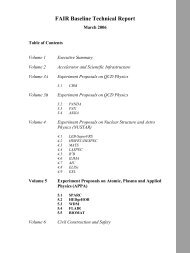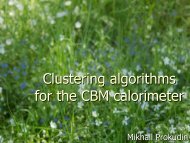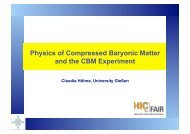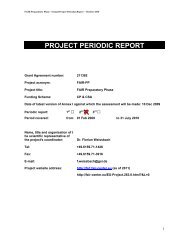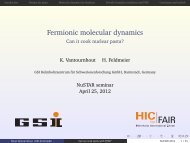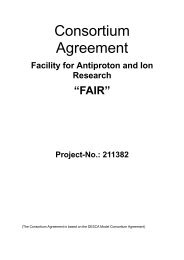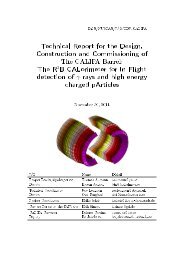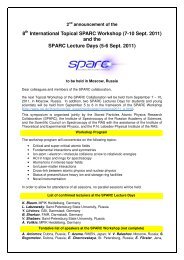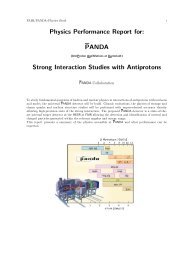NeuLAND - FAIR
NeuLAND - FAIR
NeuLAND - FAIR
Create successful ePaper yourself
Turn your PDF publications into a flip-book with our unique Google optimized e-Paper software.
exemplarily, the strength of 5% TRK sum rule is represented by a Gaussian distribution<br />
with Em = 8 MeV and a width of σ = 1 MeV. The Coulomb cross section distribution is<br />
calculated for 136 Sn projectiles impinging on a Pb-target with 1000 AMeV. According to<br />
the energy-differential Coulomb cross section distribution, events were simulated within<br />
a statistical-model approach, detailing the decay channels (1 to 4 neutrons), the neutron<br />
and fragment momenta and the γ-transitions below the particle thresholds on an eventby-event<br />
basis. Figure 4.18 presents the total excitation-energy-distribution input to the<br />
<strong>NeuLAND</strong> simulation, together with its one- to four-neutron contributions.<br />
events<br />
15000<br />
10000<br />
5000<br />
1 n<br />
2 n<br />
3 n<br />
4 n<br />
0<br />
0 10 20 30<br />
E* (MeV)<br />
Figure 4.18.: The input excitation-energy distribution is shown for a combination of PDR<br />
and GDR in 136 Sn (Coulomb excitation on a Pb target at 1000 AMeV). The<br />
overall distribution is displayed (black line), together with the composition<br />
into the 1 neutron (red), 2 neutron (cyan), 3 neutron (blue), and 4 neutron<br />
channels (magenta). The distribution is calculated for excitation energies<br />
from the one-neutron threshold up to 20 MeV.<br />
Approximately 7×10 5 events were collected into the input for the R 3 BRoot simulation of<br />
the <strong>NeuLAND</strong> response. <strong>NeuLAND</strong> is located at a distance of 23.5 m to the target in this<br />
simulation. Neutrons were reconstructed from the <strong>NeuLAND</strong> tracking algorithm output.<br />
Together with the momentum of the fragment and the γ-transitions, the excitation<br />
energy was reconstructed using the invariant-mass method. Since our aim is to study<br />
the performance of the response of <strong>NeuLAND</strong>, γ-transitions and the heavy fragment<br />
were treated as ideal.<br />
Figure 4.19 displays the comparison of the excitation-energy-distribution input to the<br />
response of <strong>NeuLAND</strong> from the R 3 BRoot simulation. For the reconstruction, neutron<br />
multiplicities of 1 to 4 were taken into account. The mass of the projectile fragment<br />
is used as a cross check for the detection of the each neutron channel. Thus, only<br />
channels with the correctly identified neutron multiplicities (diagonal elements of the<br />
60





